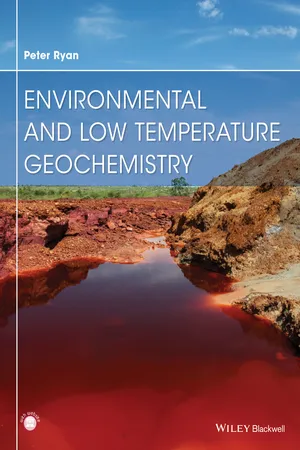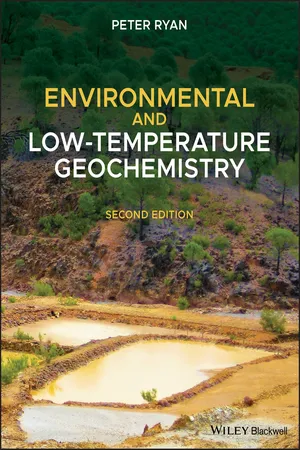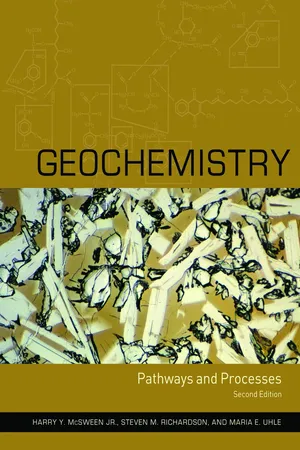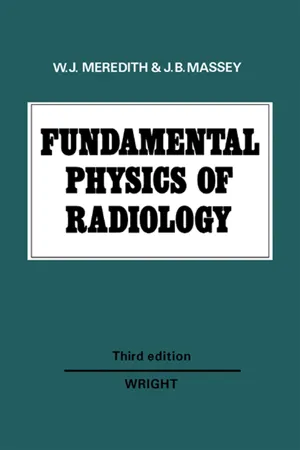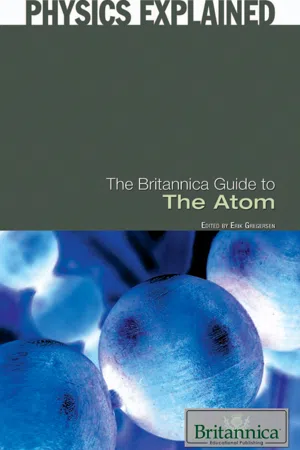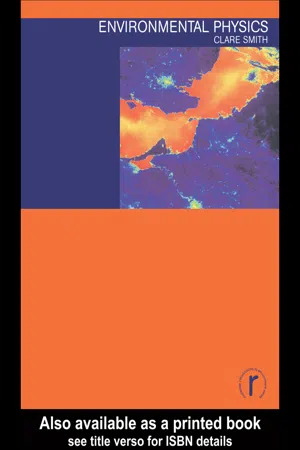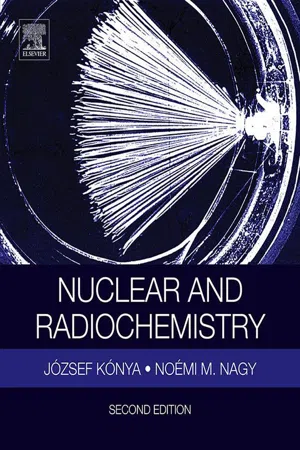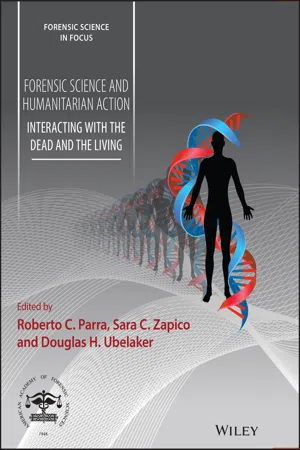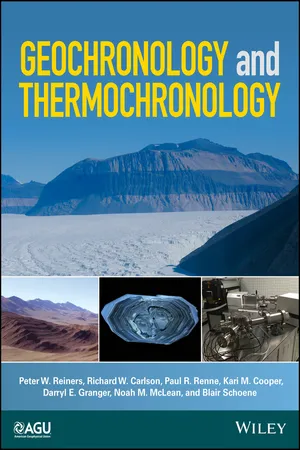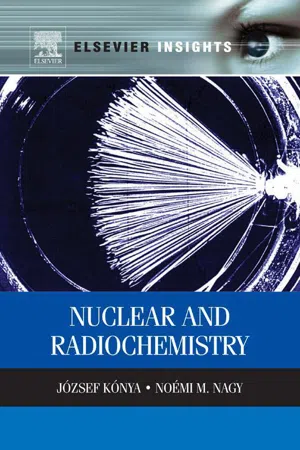Chemistry
Radioactive Isotopes
Radioactive isotopes are atoms of the same element with the same number of protons but different numbers of neutrons, resulting in varying atomic masses. These isotopes are unstable and undergo radioactive decay, emitting radiation in the form of alpha, beta, or gamma particles. They are used in various applications, including medical imaging, cancer treatment, and dating archaeological artifacts.
Written by Perlego with AI-assistance
Related key terms
Related key terms
1 of 4
Related key terms
1 of 3
12 Key excerpts on "Radioactive Isotopes"
- eBook - ePub
- Peter Ryan(Author)
- 2014(Publication Date)
- Wiley-Blackwell(Publisher)
11 Radioactive and Radiogenic Isotope GeochemistryRadioactive Isotopes, whether naturally occurring (e.g. 14 C, 235 U and 238 U) or synthetic (e.g. 99 Tc, 239 Pu), are characterized by atoms with unstable nuclei that undergo radioactive decay to daughter isotopes, which, because they form by radioactive decay, are termed radiogenic. These daughter products also may be radioactive, or they may be stable (e.g. decay of radioactive 40 K to stable 40 Ca mentioned at the end of Chapter 10 ). Radioactive and radiogenic isotopes are useful in environmental analysis in much the same way that stable isotopes are – some are useful tracers of geochemical and biochemical reactions – and radioactive-radiogenic isotopes are the most common approach to quantitative dating of rocks, sediments, soils, groundwater and organic matter. Some radioactive elements, whether naturally occurring or anthropogenic, are toxic, so geochemical research has also focused on the behavior of various radionuclides in environmental systems.This chapter begins with some fundamentals of radioactive decay and radioactive-radiogenic elements, then moves on to examples of radionuclides applied to environmental and low-temperature geochemistry.11.1 Radioactive Decay
The nuclei of Radioactive Isotopes undergo spontaneous decay to daughter atoms (which may be stable or radioactive) via various mechanisms, all of which release energy and particles, and regardless of the mechanism, radioactive decay produces a change in both Z (# of protons) and N - eBook - ePub
- Peter Ryan(Author)
- 2019(Publication Date)
- Wiley-Blackwell(Publisher)
11 Radioactive and Radiogenic Isotope Geochemistry Radioactive Isotopes, whether naturally occurring (e.g. 14 C, 235 U, and 238 U) or synthetic (e.g. 99 Tc, 239 Pu) are characterized by atoms with unstable nuclei that undergo radioactive decay to daughter isotopes, which, because they form by radioactive decay, are termed radiogenic. These daughter products may also be radioactive, or they may be stable. Radioactive and radiogenic isotopes are useful in environmental analysis much in the same way that stable isotopes are, i.e. as tracers of geochemical and biochemical reactions. A very common approach to quantitative dating of rocks, sediments, soils, groundwater, and organic matter is radioactive decay methods. Some radioactive elements, whether naturally occurring or anthropogenic, are toxic, so geochemical research has also focused on the behavior of various radionuclides in environmental systems. This chapter begins with some fundamentals of radioactive decay and radioactive‐radiogenic elements, then moves on to examples of radionuclides applied to environmental and low‐temperature geochemistry. 11.1 Radioactive Decay The nuclei of Radioactive Isotopes undergo spontaneous decay to daughter atoms (which may be stable or radioactive) via various mechanisms, all of which release energy and particles. Regardless of the mechanism, radioactive decay produces a change in both Z (# of protons) and N (# of neutrons) from parent to daughter isotope (note: atomic mass may remain unchanged depending on decay mechanism) - eBook - ePub
Geochemistry
Pathways and Processes
- Harry McSween, Steven Richardson, Maria Uhle(Authors)
- 2003(Publication Date)
- Columbia University Press(Publisher)
chapter 2 , we saw that only ∼260 of the 1700 known nuclides are stable, so we can infer that nuclide stability is the exception rather than the rule. Most of the known Radioactive Isotopes do not occur in nature. Although some of these may have occurred naturally in the distant past, their decay rates were so rapid that they have long since been transformed into other nuclides. In most cases, Radioactive Isotopes that are of interest to geochemists require very long times for decay or are produced continually by naturally occurring nuclear reactions.In chapter 13 , we explored how variations in stable isotopes are caused by mass fractionation during the course of chemical reactions or physical processes. With the exception of radioactive 14 C and a few other nuclides, the atomic masses of most of the unstable isotopes of geochemical interest are very large, so that mass differences with other nuclides of the same element are minuscule. Consequently, these isotopic systems can be considered to be immune to mass fractionation processes. Thus, all of the measured variations in these nuclides are normally ascribed to radioactive decay.Decay MechanismsRadioactivity is the spontaneous transformation of an unstable nuclide (the parent) into another nuclide (the daughter). The transformation process, calledradioactive decay, results in changes in N (the number of neutrons) and Z (the number of protons) of the parent atom, so that another element is produced. Such processes occur by emission or capture of a variety of nuclear particles. Isotopes produced by the decay of other isotopes are said to be radiogenic. The radiogenic daughter may be stable or unstable; if it is unstable, the decay process continues until a stable nuclide is produced.Beta decay involves the emission of negatively charged beta particles (electrons emitted by the nucleus), commonly accompanied by radiation in the form of gamma rays. This is equivalent to the transformation of a neutron into a proton and an electron. As illustrated in figure 14.1 , Z increases by one and N - eBook - ePub
- W. J. Meredith, J. B. Massey(Authors)
- 2013(Publication Date)
- Butterworth-Heinemann(Publisher)
CHAPTER XXVIIIRadioactive Isotopes IN CLINICAL MEDICINE
Publisher Summary
This chapter discusses the applications of Radioactive Isotopes in clinical medicine. These isotopes are particularly valuable tools because they enter into any chemical reaction or metabolic process in exactly the same way as would their stable isotopes and also they reveal their presence by the radiation they emit. These isotopes are used in medicine in four different ways: as gamma-ray beam sources; as alternatives for radium or radon in plesiotherapy; for internal administration for therapeutic purposes; and for tracer studies for diagnostic or research purposes. With the widespread development of atomic energy resources, abundant supplies of these isotopes are readily available in a wide variety of chemical forms. The chapter also discusses the more important general principles and some examples of their application.As CHAPTER IV has already indicated, Radioactive Isotopes of practically every element can now be produced ‘artificially’, that is to say by neutron or proton bombardment, or from the ‘fission fragments’ of the uranium fission process. With the widespread development of atomic (or, more correctly, nuclear) energy resources, abundant supplies of these isotopes are readily available in a wide variety of chemical forms. They are used in medicine in four different ways:1. As gamma-ray beam sources. 2. As alternatives for radium or radon in plesiotherapy. 3. For internal administration for therapeutic purposes. 4. For ‘tracer’ studies for diagnostic or research purposes.The first two of these uses, which exploit the materials solely as sources of radiation will be discussed in CHAPTERS XXXVIII and XL . The third and fourth uses exploit both the radioactive (radiation emitting) and the isotopic (same chemical properties) features of the materials. If a substance is known to play some part in a process in the body, it may be possible to introduce a radioactive version of that substance (often spoken of as a ‘labelled’ material) into the system where it will behave exactly like its non-radioactive counterpart. This may be done either to deliver a therapeutic dose of radiation to particular tissues or, for diagnostic purposes, to enable the interaction of the material with the body to be followed with the aid of emitted radiations—often called ‘tracer studies’. The properties of some of the radioactive materials found useful for these purposes are given in Table XXXI - eBook - ePub
- Britannica Educational Publishing, Erik Gregersen(Authors)
- 2010(Publication Date)
- Britannica Educational Publishing(Publisher)
Under ordinary conditions, the disintegration of each radioactive isotope proceeds at a well-defined and characteristic rate. Thus, without replenishment, any radioactive isotope will ultimately vanish. Some isotopes, however, decay so slowly that they persist on Earth today even after the passage of more than 4.5 billion years since the last significant injection of freshly synthesized atoms from some nearby star. Examples of such long-lived radioisotopes include potassium-40, rubidium-87, neodymium-144, uranium-235, uranium-238, and thorium-232.In this context, the widespread occurrence of radioisotopes that decay more rapidly, such as radon-222 and carbon-14, may at first seem puzzling. The explanation of the apparent paradox is that nuclides in this category are continually replenished by specialized nuclear processes: by the slow decay of uranium in Earth in the case of radon and by the interactions of cosmic rays with the atmosphere in the case of carbon-14. Nuclear testing and the release of material from nuclear reactors also introduce Radioactive Isotopes into the environment.Nuclear physicists have expended great effort to create isotopes not detected in nature, partly as a way to test theories of nuclear stability. In 2006 a team of researchers at the Joint Institute for Nuclear Research in Dubna, near Moscow, and at the Lawrence Livermore National Laboratory, in Livermore, Calif., U.S., announced the creation of element 118, with 118 protons and 176 neutrons. Like most isotopes of elements heavier than uranium, it is radioactive, decaying in fractions of a second into more common elements.ELEMENTAL AND ISOTOPIC ABUNDANCES
The composition of any object can be given as a set of elemental and isotopic abundances. One may speak, for example, of the composition of the ocean, the solar system, or indeed the Galaxy in terms of its respective elemental and isotopic abundances. Formally, the phrase elemental abundances - eBook - ePub
- James R Hanson(Author)
- 2019(Publication Date)
- Royal Society of Chemistry(Publisher)
CHAPTER 1 The Discovery and Detection of Isotopes1.1 INTRODUCTION
Labelled compounds in which a specific atom has been replaced by an isotope have played a major role in elucidating reaction mechanisms in chemistry, in establishing metabolic pathways in biochemistry and in imaging organs in medicine. This book is concerned with the organic chemistry that has been used in the synthesis of isotopically labelled compounds employed in these studies.The isotopes of an element have a nucleus with the same number of protons but vary in the number of neutrons that are present. Each isotope of an element has the same atomic number but a different atomic mass. Since the different isotopes of the same element have the same number of protons and electrons, their overall chemical properties are virtually identical, although there may be subtle differences associated with reaction rates. However, the physical properties of isotopes can differ sufficiently to allow their presence to be detected. Some isotopes such as deuterium and carbon-13 are stable whereas others such as tritium and carbon-14 are unstable and undergo radioactive decay. Since isotopes can be detected by differences in their physical properties, they can act as tracers for the origin and fate of particular atoms within a molecule in the course of a reaction. The application of isotopic tracers in chemistry, biochemistry and medicine has led to the solution of many problems of wide interest.1.2 THE DISCOVERY OF ISOTOPES
The discovery, isolation and utilization of isotopes took place throughout the twentieth century. As their availability and the methods for their detection became more refined, so the nature of the problems that could be examined by isotopic methods changed. After the discovery of X-rays by Röntgen in 1895, the first physical observations of radioactivity were reported in 1896 by Becquerel. In 1898, studies by Marie Curie and her husband Pierre Curie on the uranium ore pitchblende led to the isolation of the radioactive elements polonium, a congener of bismuth, and radium, which was obtained from the barium fraction. Further radioactive elements were then discovered associated with thorium. - eBook - ePub
Mathematica Beyond Mathematics
The Wolfram Language in the Real World
- José Guillermo Sánchez León(Author)
- 2022(Publication Date)
- Chapman and Hall/CRC(Publisher)
9Nuclei and RadiationsRadioactivity is a natural phenomenon that allows us to peek into our planet's past and the history of humankind. Its effects when absorbed by human beings can also be scientifically measured. This chapter covers radioactivity and other topics related to nuclear and particle physics with examples such as the modeling of the evolution of isotopes over time or the dating of the history of humankind. The last two sections discuss the calculation of binding energies and how to design products that protect from radiation respectively. Throughout the chapter, the Mathematica functions IsotopeData and ParticleData are used extensively.9.1 Nuclear and Particle Physics
The Entity[“Isotope”, name] (or IsotopeData) and ParticleData functions deal with nuclear and particle physics applications.- Writing the isotope name inside an Inline Free-form input orIsotopeData[“isotope”, “property”] returns the value of the specified property for a given isotope.
- The next example shows some of properties of Iodine-131.In[• ]:=IsotopeData["Iodine131", #] & / @{"FullSymbol", "AtomicMass", "BranchingRatios", "DecayModes", "DaughterNuclides", "HalfLife", "IsotopeAbundance"}Out[• ]={, 130.906124609 u, {1.00}, {BetaDecay}, {xenon-131 }, 6.9338×105 s, 0}53131I 78The output tells us that this isotope, whose complete symbol is, has an atomic mass of 130.09061 atomic mass units (amu), with a single type of radioactive decay, a beta decay, that disintegrates into Xenon-131 with a disintegration period of 6.9338 × 105 and that it doesn't exist in natural form (0.).53 131I 78
- The example below generates a dataset with information about all the properties available for Iodine-131.
9.2 What Are Isotopes?
Matter consists of atoms that can be described in a simple way as a central part named the nucleus, containing neutrons and protons, surrounded by an electron cloud. Atomic elements have the same number of protons, but the number of neutrons may change. Nuclei with the same number of protons, Z, and a different one for neutrons, N, are the isotopes of that element. Normally, an isotope is written as A X, where X is the symbol of the element and A is the mass number given by A = Z + N. For example: atmospheric carbon consists of 3 isotopes: Carbon-12 (or 12 C) with 6 protons and 6 neutrons, Carbon-13 (or 13 C) with 6 protons and 7 neutrons and Carbon-14 (or 14 C - eBook - ePub
- Clare Smith(Author)
- 2004(Publication Date)
- Routledge(Publisher)
7 Radioactivity and nuclear physicsRadioactivity is not Just about nuclear power stations. Radioactive emissions arise from many activities, from hospitals to coal mining, natural leakage from rocks to household refuse. Apart from these potential hazards, radioactivity has many uses in monitoring and understanding of the environment. The following key concepts are covered in this chapter:• Nuclear reactions depend upon the binding energy in the atomic nucleus• Ionising radiation has sufficient energy to ionise target molecules, causing chemical changes and cell damage• Radioactive Isotopes are those which undergo radioactive decay, at a rate measured by their halflives• Fissile isotopes may take part in fission reactions such as that used in nuclear power, releasing large amounts of energy• The design of nuclear power stations and other installations in the nuclear fuel cycle aims to keep both routine emissions and risk of accidental release within safety standards, requiring detailed knowledge of the nuclear reactions occurring• Fusion reactions involve two light nuclei such as hydrogen combining into one, with possible future potential for power productionCarbon dating and other forms of radiometric dating are vital tools to look at prehistory; radioactivity in plants and algae is used in biomonitoring; radioactive fallout from atmospheric nuclear testing can be used to measure soil erosion; radioactive tracers are widely used in medicine and radioactivity is used in all sorts of devices from X-rays to smoke alarms. In this chapter we will start with some basics of nuclear structure and processes, giving details on some environmental uses and hazards of radioactivity, and move on to cover the principles of nuclear power. - eBook - ePub
- Jozsef Konya, Noemi M. Nagy(Authors)
- 2018(Publication Date)
- Elsevier(Publisher)
Section 10.1 ).The second group of the analytical applications of radioactivity includes the methods in which the samples are irradiated by particles or electromagnetic radiation; and the impacts of these radiations on the matter or the change in the properties of the irradiating particles or photons are studied. This means that analytical and structural information are obtained via studying the interactions of radiation with matter (see Section 10.2 ).10.1 Radioactive Isotopes as Tracers
10.1.1 The Measurement of Concentration Using Natural Radioactive Isotopes
The quantity of an element present in the same sample can be determined if the relative abundance of its isotopes is constant, and among these isotopes, there is at least one natural radioactive isotope with a long half-life. Such elements are potassium, rubidium, samarium, lutetium, rhenium, and uranium. In these concentration measurements, the activity of the Radioactive Isotopes is measured. When the relative abundance of the Radioactive Isotopes is known, the quantity of the element that is present can be calculated from Eq. (4.12) , taking into account the relative abundance of the Radioactive Isotopes.As an example, the data required for the quantitative measurement of lutetium is illustrated in Table 10.1 . The 176 Lu isotope, which is in natural lutetium in 2.59%, is used for the measurements. As calculated from the data in Table 10.1 , 10−4 mol of lutetium provide about 100 dpm of activity. This activity can be measured easily by a 4π-counter (as described in Section 14.6 - eBook - ePub
Forensic Science and Humanitarian Action
Interacting with the Dead and the Living
- Roberto C. Parra, Sara C. Zapico, Douglas H. Ubelaker, Roberto C. Parra, Sara C. Zapico, Douglas H. Ubelaker(Authors)
- 2020(Publication Date)
- Wiley(Publisher)
CHAPTER 19 The role of stable isotope analysis in forensic anthropology Douglas H. Ubelaker and Caroline FrancescuttiDepartment of Anthropology, National Museum of Natural History, Smithsonian Institution, Washington, DC, USA19.1 Introduction
In recent decades, forensic anthropologists have added chemical analysis of human tissues to their methodological toolkits. Laboratory examinations of chemical composition have facilitated estimations of time since death through bomb‐curve radiocarbon analysis (Ubelaker, 2014 ) and amino acid racemization (Bada and Schroeder, 1975 ). Chemical approaches now also assist in the estimation of age at death (Zapico and Ubelaker, 2015 ). Analysis of trace elements and, more recently popularized, stable isotopes can reveal important details of diet and the life history of individuals. New research on variations of the geographical distribution of quantities of stable isotopes in human tissues offers exciting possibilities for addressing key issues of migration. Such information is vitally needed to assist identification efforts and to investigate acts of terrorism and civil strife.Isotopes are forms of a chemical element that differ in the number of neutrons that exist in the nucleus of the atom. This results in a series of the same element with different atomic masses, and as a result differing physical properties, despite the same chemical properties. There are two forms of isotopes: radioactive and stable.Radioactive Isotopes are unstable and as a result the atom will spontaneously decay. Stable isotopes are nuclides that are not radioactive, and while they could theoretically spontaneously decay, the probability of such is insignificant. We can safely assume they are stable and will not decay (Sharp, 2007 ).Stable isotopes have proven to be of great use to the field of archaeology, and more recently in forensic anthropology. In bioarchaeology, stable isotopes in human remains are largely used to determine the diet of ancient populations, following reduced interest in use of trace elements due to diagenesis. This application of stable isotopes is used in forensic investigations; however, stable isotopes have recently proven to be very useful in locating an individual’s origin prior to death. The analysis of stable isotopes from forensic remains has further been able to discern where the individual was born, where they lived most of their life and where they had travelled to prior to their death. Isotope analysis can also clarify whether or not they died in the region where their remains were found, or if they had been moved post‐mortem. - eBook - ePub
- Peter W. Reiners, Richard W. Carlson, Paul R. Renne, Kari M. Cooper, Darryl E. Granger, Noah M. McLean, Blair Schoene(Authors)
- 2017(Publication Date)
- American Geophysical Union(Publisher)
CHAPTER 2 Foundations of radioisotopic dating2.1 INTRODUCTION
Radioactivity, and the geologic clock it provides, is a property of the atomic nucleus. The delineation of the fundamentals of atomic structure occurred over just a couple of decades around the transition from the 19th to 20th century [e.g., Reed, 2014, chapter 2 ]. Understanding the structure of the atom and its constituent particles was without a doubt a first‐order advance in our understanding of the nature of matter. Atomic structure provided explanations for the systematic, but often mysterious, behavior of the elements that had been seen over centuries of exploitation of natural ores. While the electrons of an atom primarily control the chemical behavior of an element, the behavior of the nucleus is the foundation of radioisotope geochronology. The importance of this application of nuclear physics is reflected in the fact that the first age determination for a rock using this technique occurred only eight years after the discovery of the first atomic particle, the electron [e.g., Radash, 1968]. The basic understanding of the physics of the nucleus provides the tool by which geoscientists over the following century, and continuing today, are able to use naturally occurring isotopic variations in Earth and planetary materials to address a vast range of topics, including questions relating to:the origin of the elements in the solar system; the chronology and processes involved in planet formation; the geologic evolution of Earth and other planets; the rates of plate tectonics, basin subsidence, and mountain building; absolute ages for the geologic timescale and the evolution of life; rates of erosion and modification of the near‐surface environment; temporal changes in the composition of the atmosphere and the rise of oxygen; paleoclimate, paleoecology, and paleogeography.Geology is in essence the history of the Earth, and for any history dates are absolutely essential. Radioisotope geochronology provides the means to decipher the timescale and rates of all the processes that have created and modified Earth and its surface environment. Understanding the physics of the nucleus and how it leads to stable, and unstable, nuclei provides the background on both the strengths and some of the weaknesses in using radioactive decay as a chronometer. - eBook - ePub
- Jozsef Konya, Noemi M. Nagy(Authors)
- 2012(Publication Date)
- Elsevier(Publisher)
Physicochemical applications include, for example, the determination of solubility, the study of diffusion, the distribution of substance between phases, and the study of reaction mechanisms. It is important to note that radiotracer methods are widely used in the study of interfacial processes because of the high sensitivity of radioindicators. Analytical applications include the radiometric analysis, isotopic dilution methods (including RIA), autoradiography, neutron activation analysis, and all analytical methods based on the interaction of radiation with matter (see the discussion of this in Chapter 10). Isotope labeling can also be done by stable isotopes, in which case the natural abundance of a given element is altered. In other words, a stable isotope is enriched. The concentration of the stable isotopes can be determined in two ways: • The samples are activated after the studies and the number of isotopes is determined on the basis of the produced radioactive nuclides. • The number of isotopes can be determined by mass spectrometry, infra spectrometry, and so on. These methods, however, are much more complicated than simple radioactivity measurement methods. Of course, the basic concepts of labeling by stable isotopes are just the same as those of Radioactive Isotopes, only the detection methods are different. Therefore, all of the principles and relation mentioned above for Radioactive Isotopes apply to stable isotopes. 9.3 Physicochemical Applications of Tracer Methods Because of the easy detection of their radiation, Radioactive Isotopes provide a useful approach to determine the local, time, and concentration distribution of substances. Consequently, the radioisotopic tracer method can be used for reaction kinetic, mechanism, and equilibrium studies. In this chapter, some radiotracer methods will be shown
Index pages curate the most relevant extracts from our library of academic textbooks. They’ve been created using an in-house natural language model (NLM), each adding context and meaning to key research topics.
Explore more topic indexes
Explore more topic indexes
1 of 6
Explore more topic indexes
1 of 4
